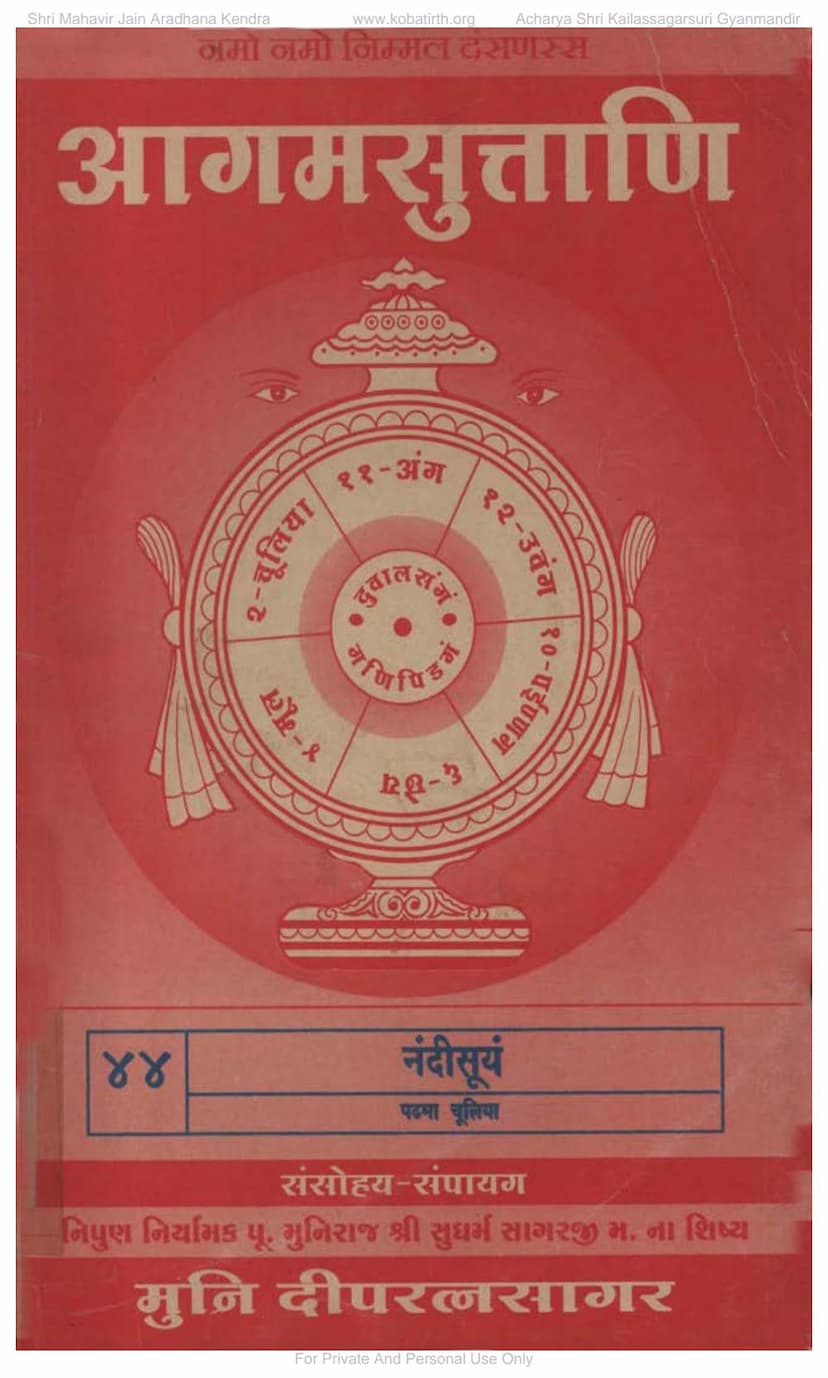Agam 44 Nandisuyam Chulikasutt 01 Moolam
Added to library: September 1, 2025

Summary
Here is a comprehensive summary of the Jain text "Agam 44 Nandisuyam Chulikasutt 01 Moolam":
Book Title: Agam 44 Nandisuyam Chulikasutt 01 Moolam Author(s): Dipratnasagar, Deepratnasagar Publisher: Agam Shrut Prakashan Catalog Link: https://jainqq.org/explore/009774/1
This document is the first chapter (Chulika) of the 44th Agam Sutra, titled "Nandisuyam" (or "Nandi Sutra"), compiled and presented by Muni Dipparatnasagar, a disciple of Muni Sudharmasagarji. It is published by Agam Shrut Prakashan.
Key Aspects and Content:
-
Title and Context: The text is part of the Agam Sutras, which are the sacred scriptures of Jainism. Specifically, it belongs to the group of 12 Angas, within the 11 Angas, under the classification of 44 Agam Sutras. The title "Nandisuyam" indicates its connection to the concept of "Nandi" or auspiciousness and knowledge.
-
Dedication and Acknowledgments: The publication is dedicated to the spiritual lineage of Acharya Shri Kailassagarsuri and other revered Jain monks and nuns. The initial pages show acknowledgments and thanks to numerous donors and patrons who financially supported the publication of this Agam text. These patrons are listed with their names, families, and locations, highlighting a collective effort in preserving and disseminating Jain scriptures.
-
Structure and Content of the Agam Sutra:
- The text begins with invocations and salutations to Lord Mahavir and other revered beings, a common practice in Jain scriptures.
- The main body of the text appears to be a detailed exposition of knowledge (Jnana), a central theme in Jain philosophy. It systematically breaks down different types of knowledge.
- Types of Knowledge (Jnana): The text elaborates on the following categories of knowledge:
- Pratyaksh (Direct Perception): This is further divided into Indriya Pratyaksh (knowledge through the senses) and No-Indriya Pratyaksh (knowledge beyond the senses).
- Indriya Pratyaksh is explained through the five senses: hearing, sight, smell, taste, and touch.
- No-Indriya Pratyaksh includes Moha Jnana (Intuitive knowledge), Manaparyavaya Jnana (Telepathy), and Kevala Jnana (Omniscience).
- Paroksh (Indirect Knowledge): This is described as consisting of Abhinibodhika Jnana (Sensory-based knowledge) and Shrut Jnana (Scriptural knowledge).
- Pratyaksh (Direct Perception): This is further divided into Indriya Pratyaksh (knowledge through the senses) and No-Indriya Pratyaksh (knowledge beyond the senses).
- Detailed Classification of Knowledge: The text meticulously defines and categorizes various types of knowledge, including:
- Shrut Jnana (Scriptural Knowledge): It discusses its classification as Akshara (with letters) and Anakshara (without letters), and further sub-classifications like Sannishruta (with analysis), Asannishruta (without analysis), Sammata (correct scripture), and Mithya (false scripture). It also details its derivation through Ugraha, Iha, Avaya, and Dharana.
- Moha Jnana (Intuitive Knowledge): The text elaborates on its various types, including its scope based on matter (dravya), space (kshetra), time (kala), and state (bhava). It distinguishes between the knowledge of those who have achieved the apex of intuition (Anugaami) and those whose intuition is limited (Anaanugaami). It further categorizes the former into Antargata (internal) and Madhya-gata (middle), and the latter based on its nature of expansion or contraction.
- Manaparyavaya Jnana (Telepathy): This is explained as the knowledge of the thoughts of others, distinguishing between Ujuma (straightforward) and Vipulmati (extensive) forms.
- Kevala Jnana (Omniscience): This is described as the ultimate, pure, direct, and complete knowledge, encompassing all beings and all phenomena. It is divided into Bhavastha Kevala Jnana (Omniscience in a state of existence) and Siddha Kevala Jnana (Omniscience in a liberated state).
- The Twelve Angas and Fourteen Purvas: The text extensively discusses the structure and content of the twelve Angas of Jain canon and mentions the fourteen Purvas (ancient scriptures). It details what each Anga comprises, including its subject matter, number of chapters, subdivisions, and the number of verses or stanzas.
- "Anunana" (अनुज्ञा) and "Yoganandi" (योगनंदी): The appended sections, "Anunana" and "Yoganandi," delve into specific concepts.
- Anunana seems to refer to permission, sanction, or consent. It is categorized based on name, designation, substance, place, time, and state, with detailed examples of who can grant such "anunana" in various contexts (e.g., royalty, spiritual leaders).
- Yoganandi appears to be related to the practice of Yoga or spiritual discipline. It discusses the importance of Shrut Jnana (scriptural knowledge) in the path of liberation and how it is studied, understood, and retained. It also touches upon the classification of different types of scriptures and their study.
-
Editorial and Publication Information: The document includes information about the publisher, printing press, and the individuals involved in the project, emphasizing the dedication to accuracy and clarity. There's also a mention of the cost of the complete set of Agam Sutras.
-
Appendices (Parishisht): The end of the document lists several appendices that are planned for future publication, indicating a comprehensive approach to studying the Agams. These include:
- Vishay Anukramanika (Subject Index): A broad index of the topics covered in Agams 45-49.
- Visishta ShabdAnukramo (Special Word Index): An alphabetical index of specific Jain terms found in the Agams, with their locations.
- Vishesh NamAnukramo (Proper Noun Index): An alphabetical list of specific names mentioned in the Agams.
- GathAnukramo (Verse Index): An index of verses (Gathas) in alphabetical order.
- SutrAnukramo (Sutra Index): An index of sutras in alphabetical order.
Overall Significance:
This text, "Agam 44 Nandisuyam Chulikasutt 01 Moolam," is a foundational scripture within Jainism, focusing on the classification and understanding of various types of knowledge. It demonstrates the intricate analytical framework of Jain philosophy regarding epistemology. The meticulous detail in defining and categorizing knowledge underscores the Jain emphasis on right faith, right knowledge, and right conduct as the path to liberation. The presentation also highlights the commitment of Jain scholars and institutions to preserve and make these ancient texts accessible to modern readers.